Inspired by the giant, steampunk octopus of Burning Man, “El Pulpo Mechanico”, and a favorite video game character of mine, Fallout 4‘s “Codsworth”, I decided to use steampunk as the aesthetic of my Upcycle project and build a much smaller-scale jellyfish. My initial plans for materials included (but were not limited to) light bulbs, guitar strings, scrap metal, a wheel and other metallic office supplies. I ended up using far fewer metallic materials than I anticipated and instead used color to create the metallic look and effect. This was a far more economical option, which I felt was an important element of the project. The jellyfish is a purely aesthetic piece that mimics both a large-scale art piece and video game favorite character of mine. I incorporated several new materials as I progressed and I feel that these additions contribute to the steampunk vibe of having scattered bits and pieces. While there are artists who have imagined this idea before, I intended to make it something completely my own.
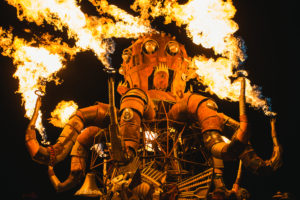
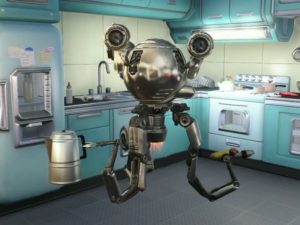
I find that I like to plan things out in a very succinct, organized way, which I can probably attribute to the engineering background provided to me over the last few years. However, I also find that I become very nit-picky when something doesn’t go the way I imagine it to, which results in multiple, somewhat random design iterations. Both observations are reflected in the design loop that I prescribed myself and the one that I actually followed while creating my Upcycle project.
I struggled quite a bit initially to even come up with an idea for an Upcycle project. I imagined just sort of throwing “stuff” together until it resembled something useful or aesthetically pleasing. Stuff is in quotes because I really had no clue what kind of materials I wanted to use either. I think this is a good realization because it validates the exploration of design: there is no one right way to create something!
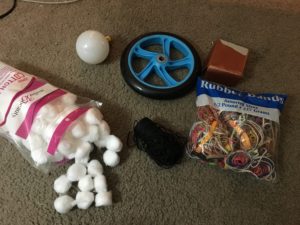
When I finally decided to create a sort of steampunk-style jellyfish, I classified it as something whimsical that I could experiment with the design of. The image above displays all the materials that I began designing and building with. I had ideas for what I wanted to do to create structural integrity. I had ideas for what I wanted to do to create the appropriate aesthetic at first glance. However, I came to find that not all things worked quite as well as I thought they would. So, I began with the prescribed design loop below, expecting to at least roughly follow it. Although I did roughly follow it, there were some modifications made shown in the actual design loop. These changes account for the iterative design process of just starting to build upon something and then realizing that it wasn’t what I thought it would be.
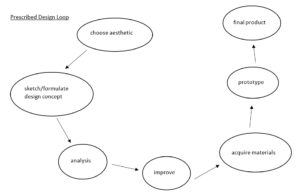
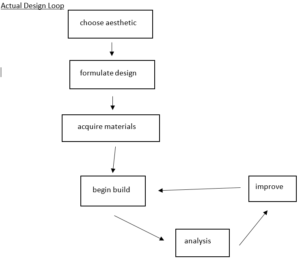
At this point, it would be appropriate to create a new design loop schematic that includes both the majority of the build (after begin build is cycled back to once or twice) and the dead-end of the final product. I did not feel as though I followed any sort of design loop, but rather I designed the project while I was constructing it with an end result in mind.
My major goal for this project was to make something out of what I saw as “nothing” (i.e. things that have a specific purpose and don’t organically go together). When I began with a pile of random materials, I had no idea how I would turn it into my vision other than the base fact that I needed to construct a lot of support structure (to hold the rounded shape). So I began brainstorming ideas for this.
The initial idea for main support was a light bulb, because it was the largest, most structurally rigid element I had. This was also a major choice because the original, optimistic design concept included functionality of the jellyfish as a lamp. Due to constraints, I chose instead to make my project purely aesthetic. However, the light bulb is still an essential component for the design as it stands.

After many attempts at getting the light bulb to stay upright with hemp string, my roommate (Trevor Jargon) suggested using the rubber bands with pencils to create tension that would trap the light bulb. What a wonderful idea! This ended up being the most important structural element of my project.
I knew that I would use the cotton balls as filler for the body of the jellyfish, but I had to create a border around the wheel with them first. This way, adding more materials as filler would not cause the design to fail. To achieve this, I strung cotton balls onto the hemp string and tied it off multiple times at different locations on the wheel.

I then filled in the space around the light bulb with tissues and cotton balls. To create the rounded top shape of the jellyfish, I used multiple strands of masking tape with cotton balls attached to them which were held in tension across the wheel and over the light bulb.
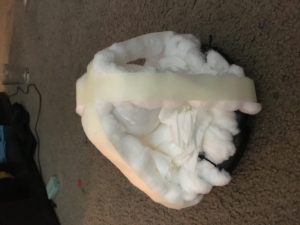
I continued the pattern until the full body of the jellyfish was constructed. At this time, I acquired a small, battery-powered, multi-colored light with a switch on the back. The light was small enough to fit into the jellyfish on any side, and I thought that it brought a really intriguing aesthetic component to the project. I used a small jewelry box (with a hole of same radius cut) to contain and prop up the light within the rest of the piece. The box was later taped at the bottom edge and a short way up the side edges to attach it to the project while still having the ability to pull it forward to switch the light on.
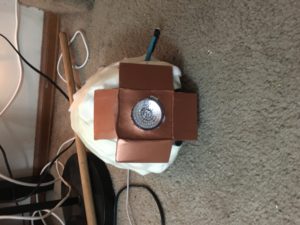
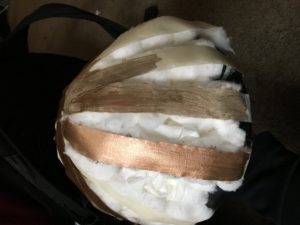
To create the appropriate color aesthetic, I needed to find something that would make my masking tape look metallic. I tested both a metallic permanent marker and a “paint pen” to decide which color I would use. I actually did test it on a lone piece of tape first, but the results changed when I applied the color to the whole project. The image on the right shows the results, in which the paint pen won by a landslide. With this in mind, I used the paint pen to color the rest of my project (including the box) to achieve consistency. The only thing left to add at this point were the jellyfish tentacles. For these I used a cut-up cable that was no longer functional and some used bass guitar strings.
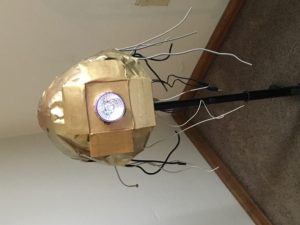
I understand that my project is not everyone’s definition of aesthetically pleasing. However, I do feel as though I achieved my design goals in this project. I wanted to make something out of nothing in a steampunk style and it turned out looking very much like what I initially pictured. I am somewhat discouraged that my jellyfish had no functionality (as I had originally intended it to), but I think that I will continue to work on this idea and potentially create a lamp that is actually made out of metal. This project will serve as a prototype for a product that will require a bit more thought and analysis.
Citations:
Video Credit:
Trevor Jargon
Photo Credits:
‘El Pulpo Mechanico’
Photographer unknown
Artist: Duane Flatmo
‘Fallout 4: Codsworth’
Lead Designer: Emil Pagliarulo

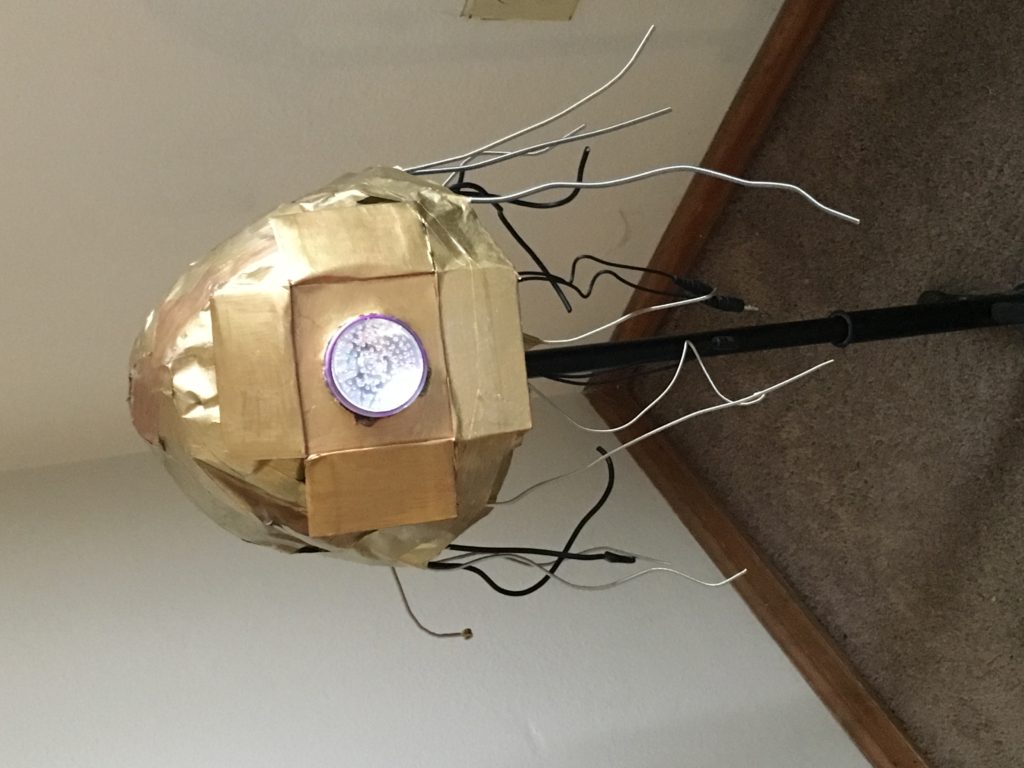
12 Comments. Leave new
Do you think it’s odd that it’s based on a lightbulb but you don’t get to see that bulb light up at all? What about movement, it could sit on a rotating pedestal, possibly with prongs that trigger wiggling of the tentacles. Super slick end product, especially when compared to the starting material. Really creative, remarkable transformation!
There were a lot of upcycled components that went into your jellyfish and it turned out great! The design is excellent, I think the light compartment is modular enough that you could add a speaker if you wanted to. Likewise, you could easily add a pipe and pull wiring through to create a lamp later on.
Excellent presentation as well! I appreciated the reference to Codsworth.
Props on creating what you envisioned. I’m a fan of creating something as you go rather than planning every single aspect in advance and your project was something that embraced that idea. I’m a fan of the color scheme.
Interesting use of the raw materials you had. Never would have thought to use cotton balls like the way you have. Steampunk is definitely not an aesthetic one would imagine if you give the materials you have used. Nice work.
This project is super creative! Jellyfish are really cool creatures so creating one with a steampunk aesthetic and an LED to make it “glow” was a great idea. The final jellyfish really fits in the steampunk world and almost resembles a miners hat too depending on how you look at it.
Interesting project! I really appreciate how well documented your project was: it really helped illustrate your design and manufacturing processes. You seem very invested in your project, and that is very cool to see. Lastly, the multicoloured light really adds to the aesthetic of the project. It gives a dynamic and electronic aspect to the project.
Had to look up what steampunk is, looks cool! Cotton balls must be hard to work with. Slides have a lot of text on them, should be more concise. I like how you used cords for the tassels that are coming down. The colors are very cool. Definitely created something out of nothing.
This is a really creative use of so many different materials. I like that you’d never know that all of that stuff was underneath the final product.
The aesthetic is really cool. I would not have known where to start if thats what I was trying to achieve.
Really cool!
A really creative use of materials for the base structure of the project. It could almost be used for a DJ helmet/mask, which would be really cool!
I like that you drew inspiration from what you had, and from there you sourced extra materials to execute the final jellyfish. Your design process was organic, which I think is refreshing in the engineering world. You addressed problems when they arose, and found simple fixes to all.
The aesthetic is great, and your execution looks really nice! Good use of images throughout your presentation to show the process in good detail.
Great idea to keep the light bulb in place and good attribution to your roommate as well.